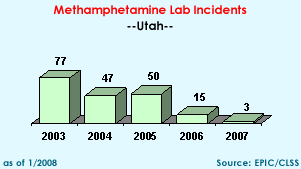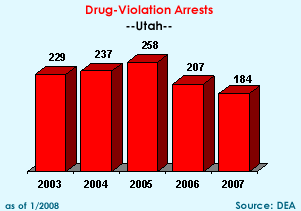DEA
Offices & Telephone Nos.
Salt Lake City—801-524-4156
St. George—435-673-6255 |
State Facts
Population: 2,469,585
State Prison Population: 5,989
Probation Population: 10,244
Violent Crime Rate
National Ranking: 43 |
2007
Federal Drug Seizures
Cocaine: 18.2 kgs.
Heroin: 8.4 kgs.
Methamphetamine: 31.9 kgs.
Marijuana: 9.9 kgs.
Hashish: 0.0 kgs.
MDMA: 0.0 kgs./3,128 du
Meth
Lab Incidents: 3
(DEA, state, and local) |
Drug
Situation: Mexican poly-drug trafficking organizations dominate all facets of illegal narcotics distribution throughout Utah. Sources of supply for methamphetamine, cocaine, heroin, and marijuana are primarily located in Mexico, California, the Southwest, and the Pacific Northwest.
  Cocaine:
Kilogram quantities of cocaine are available throughout Utah. Mexican organizations tend to dominate large-scale cocaine distribution, although several other groups are capable of distributing kilogram quantities. Prices for cocaine powder remain stable. Crack cocaine is available in limited quantities. Conversion of powder cocaine into crack takes place at the local level. Cocaine:
Kilogram quantities of cocaine are available throughout Utah. Mexican organizations tend to dominate large-scale cocaine distribution, although several other groups are capable of distributing kilogram quantities. Prices for cocaine powder remain stable. Crack cocaine is available in limited quantities. Conversion of powder cocaine into crack takes place at the local level.
 Heroin: Heroin is a serious problem in Utah. Mexican brown and black tar heroin are available throughout the state, with multi-ounce and larger quantities primarily distributed in the major cities. Most Mexican heroin distribution organizations employ “runners” who deliver heroin-filled balloons to their customers in parking lots throughout Salt Lake, Davis, and Utah Counties. Mexico and Southern California are the source areas for multi-ounce and pound quantities of heroin. Most Mexican organizations trafficking in heroin also distribute cocaine and methamphetamine. Heroin: Heroin is a serious problem in Utah. Mexican brown and black tar heroin are available throughout the state, with multi-ounce and larger quantities primarily distributed in the major cities. Most Mexican heroin distribution organizations employ “runners” who deliver heroin-filled balloons to their customers in parking lots throughout Salt Lake, Davis, and Utah Counties. Mexico and Southern California are the source areas for multi-ounce and pound quantities of heroin. Most Mexican organizations trafficking in heroin also distribute cocaine and methamphetamine.
  Methamphetamine: For the past several years, seizures of methamphetamine labs have declined substantially in Utah. In Fiscal Year (FY) 2007, only 9 labs and/or dumpsites were seized in the entire state. This is the lowest number seized in recent memory and a far cry from the peak of 272 in FY 1999. This decline is attributed to a number of factors, including strict precursor legislation, community awareness and education campaigns, as well as aggressive law enforcement efforts. Currently, most labs discovered in Utah are small, as measured by the amount of product made per cook, and rudimentary. Most are mobile labs that use the “red, white, and blue” method of manufacture. Methamphetamine: For the past several years, seizures of methamphetamine labs have declined substantially in Utah. In Fiscal Year (FY) 2007, only 9 labs and/or dumpsites were seized in the entire state. This is the lowest number seized in recent memory and a far cry from the peak of 272 in FY 1999. This decline is attributed to a number of factors, including strict precursor legislation, community awareness and education campaigns, as well as aggressive law enforcement efforts. Currently, most labs discovered in Utah are small, as measured by the amount of product made per cook, and rudimentary. Most are mobile labs that use the “red, white, and blue” method of manufacture.
The dramatic reduction in locally produced methamphetamine has been accompanied by an increase in the availability of Mexican methamphetamine. Debriefings of former methamphetamine cooks suggest that purchasing Mexican methamphetamine is now far easier and cheaper than acquiring the chemicals and the secure location needed to manufacture it.
Mexican poly-drug trafficking organizations dominate the distribution of methamphetamine, most of which is produced in Mexico, southern California, or the Southwest. The methamphetamine supplied by these organizations has increased price in the last year. In several recent investigations, traffickers charged $1,100 per ounce of methamphetamine, as compared to as little as $650-$700 per ounce in late 2005.
 Club
Drugs: MDMA and other designer drugs are a problem along the Wasatch Front. They are available primarily through bars, clubs, and private parties, as well as “rave” dances. Distribution of MDMA and other designer drugs in Utah is controlled by local criminal organizations with domestic sources of supply primarily located in California. Local organizations typically acquire multi-thousand pill quantities of MDMA tablets. One local dealer reportedly charged $6.00-$7.50 per tablet and made approximately 50 cents profit per pill. At the user level, prices rise to $10-$25 per pill. Club
Drugs: MDMA and other designer drugs are a problem along the Wasatch Front. They are available primarily through bars, clubs, and private parties, as well as “rave” dances. Distribution of MDMA and other designer drugs in Utah is controlled by local criminal organizations with domestic sources of supply primarily located in California. Local organizations typically acquire multi-thousand pill quantities of MDMA tablets. One local dealer reportedly charged $6.00-$7.50 per tablet and made approximately 50 cents profit per pill. At the user level, prices rise to $10-$25 per pill.
 Marijuana:
The majority of marijuana encountered in Utah is of Mexican origin. Marijuana is also grown in the remote areas of the state, which are most conducive for growing operations due to the fertile soil. Also, the importation of marijuana from British Columbia, Canada, remains active in Utah. Marijuana:
The majority of marijuana encountered in Utah is of Mexican origin. Marijuana is also grown in the remote areas of the state, which are most conducive for growing operations due to the fertile soil. Also, the importation of marijuana from British Columbia, Canada, remains active in Utah.
Pharmaceutical Diversion: Current
investigations indicate that diversion of OxyContin® continues
to be a problem in Utah. Primary methods of diversion being reported
are illegal sale and distribution by health care professionals and
workers, “doctor shopping” (going to a number of doctors
to obtain prescriptions for a controlled pharmaceutical), forged prescriptions,
and employee theft. Diazepam, meperidine, and methadone were also identified
as being among the most commonly abused and diverted pharmaceuticals
in Utah.
  DEA
Mobile Enforcement Teams:
This cooperative program with state and local law enforcement counterparts
was conceived in 1995 in response to the overwhelming problem of drug-related
violent crime in towns and cities across the nation. Since the inception
of the MET Program, 473 deployments have been completed nationwide, resulting
in 19,643 arrests. There have been two MET deployments in the State of
Utah since the inception of the program, in Salt Lake City and Midvale. DEA
Mobile Enforcement Teams:
This cooperative program with state and local law enforcement counterparts
was conceived in 1995 in response to the overwhelming problem of drug-related
violent crime in towns and cities across the nation. Since the inception
of the MET Program, 473 deployments have been completed nationwide, resulting
in 19,643 arrests. There have been two MET deployments in the State of
Utah since the inception of the program, in Salt Lake City and Midvale.
 DEA
Regional Enforcement Teams:
This program was designed to augment existing DEA division resources
by targeting drug organizations operating in the United States where
there is a lack of sufficient local drug law enforcement. This program
was conceived in 1999 in response to the threat posed by drug trafficking
organizations that have established networks of cells to conduct drug
trafficking operations in smaller, non-traditional trafficking locations
in the United States. As of January 31, 2005, there have been 27 deployments
nationwide, and one deployment in the U.S. Virgin Islands, resulting
in 671 arrests. There have been no RET deployments in the State of Utah. DEA
Regional Enforcement Teams:
This program was designed to augment existing DEA division resources
by targeting drug organizations operating in the United States where
there is a lack of sufficient local drug law enforcement. This program
was conceived in 1999 in response to the threat posed by drug trafficking
organizations that have established networks of cells to conduct drug
trafficking operations in smaller, non-traditional trafficking locations
in the United States. As of January 31, 2005, there have been 27 deployments
nationwide, and one deployment in the U.S. Virgin Islands, resulting
in 671 arrests. There have been no RET deployments in the State of Utah.
Special
Topics:
The State of Utah participates in the Rocky Mountain HIDTA, which is
based in Denver, Colorado. The DEA Metro Narcotics Task Force receives
funding from HIDTA. In mid-2001, a HIDTA Investigative Support Center
(ISC) was established in Utah and co-located with the DEA Salt Lake City
District Office. The ISC supports drug task forces throughout the state.
More information
about the Denver Division Office.
Sources
Factsheet
last updated:
3/2008
Click
here for last year's factsheet >>
|

